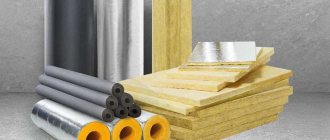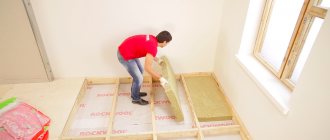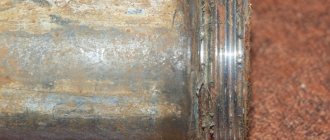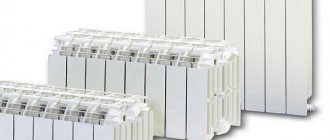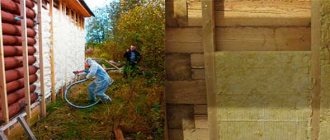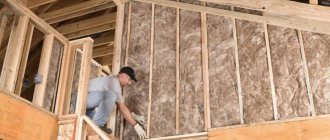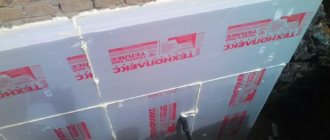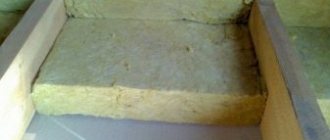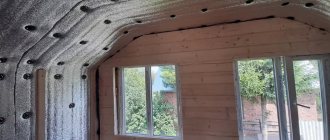Traditionally, in the wooden construction of bathhouses or residential buildings, inter-crown insulation is used to seal the joints in the walls.
The main purpose of the material is to insulate the log structure and improve the performance characteristics of the wood.
Most insulation materials contain natural components, however, some materials may contain artificial filling, which is absolutely not suitable for wooden buildings.
Why is insulation needed?
Inter-crown insulation is a universal material, therefore it is widely used for houses and baths made of rounded logs, profiled or laminated timber. In this case, the density of the insulation can be about 750 g/sq.m. with a thickness of up to 11 mm.
To reduce heat loss, the insulation is laid in one layer. It is important to remember that when using uneven or under-dried timber, the insulation is laid in several layers.
Insulation promotes timely vapor and heat insulation of wooden structures and high-quality air exchange in rooms.
When building a log bathhouse or house, an important condition is to minimize possible gaps between logs and beams. It is for this reason that work is being done to seal it with high-quality insulation.
Such measures are aimed at effectively protecting the building from adverse climatic conditions.
Production of jute fiber and fabrics from it
Jute matures within 4–5 months, after which the harvest begins. The cut stems are left in the field for several days to allow the leaves to fall, after which they are soaked in water for 1–2 weeks. In this way, the adhesive components are destroyed, and the fibers are easily separated from the stem during subsequent processing of the raw material. Next, the jute is washed, dried and sorted according to criteria such as length, elasticity and color, pressed and sent to textile production.
Stages of jute fiber production:
- Loosening the bales of jute stems received at the factory in a bale breaker.
- Softening the stems by soaking them in water, oil solutions and other substances. In this case, especially hard areas with lumps must be carefully processed.
- Mechanical softening of stems by processing in a grinder. Lumps that could not be softened with liquid and the tops are first removed. The removed particles are subsequently used to produce lower grade fibers.
- Pre-spinning – cleaning raw materials from dust and dirt, separating, straightening and folding fibers into ribbons.
- The jute is combed in 2–3 draw frames, depending on the thickness of the fibers, in which they are further straightened and thinned.
- Processing of jute in a spinning frame in which the roving is converted into yarn. Rolling of jute fibers into rolls and transfer to weaving departments for fabric production.
Performance characteristics
High-quality insulation, which is laid between the crowns of logs or beams, must meet high standards of quality and safety of use. Therefore, the main performance characteristics of the material include:
- High elasticity and density, maintaining properties throughout the entire period of operation. Thanks to its elasticity, the insulation is able to take the desired shape, and its density is able to fill existing gaps between the crowns.
- Low thermal conductivity for effective protection of walls from heat loss.
- High moisture and vapor permeability.
- Resistance to mold, fungi and harmful microorganisms that arise when exposed to increased moisture and heat.
- Resistant to ultraviolet exposure and adverse weather conditions.
How to make calculations
In order to calculate how much material is required to insulate your home, you need to follow certain rules. First, we determine the density of the insulating material, which depends on its weight, length and width. Determining these parameters will not be difficult, since the weight can be found out by weighing the material, and you know the width and length already upon purchase on the price tag.
Next you need to enter this data into the formula and calculate the result. It is known that density is directly proportional to weight, expressed in grams, and inversely proportional to the width and length of the material, expressed in meters. As a result, the resulting indicator should coincide with what is indicated by the seller (or manufacturer).
Example:
- if the thickness is 0.5 cm, then the density should be 400 g/m2;
- if the thickness is 0.8-1 cm, then the density is about 600 g/m2;
- if the thickness is 1.5 cm, then the density is about 800 g/m2.
What are the conclusions?
Lush insulation is not an indicator of quality. It is better to take insulation made using modern technologies
Adding flax to jute tape reduces the cost, but at the same time reduces the quality. The material becomes more susceptible to moth eating and rotting.
Types of interventional insulation
The modern construction market offers a large selection of natural insulation materials.
The most common options are felt, jute, moss, linen and combined.
Manufacturers also offer wear-resistant synthetic insulating materials - penofol, mineral wool, polystyrene foam boards, silicone sealants.
Without a doubt, they have higher performance characteristics in comparison with natural analogues, but they are not suitable for insulating wooden buildings.
Felt (sheep's wool)
A natural material for insulation, which in its performance properties is superior to tape insulation made from plant fibers.
Felt is a worthy option for buildings made of profiled timber. It is simply irreplaceable for insulating residential buildings and baths, although it is not cheap.
During the production process, the felt seal is carefully treated with special fire-retardant compounds, as a result of which it absorbs moisture well and quickly releases it when heated.
It is resistant to mold and mildew and does not cake during use.
Felt is suitable for insulating walls and partitions of log houses and bathhouses.
Jute
Jute material is a modern representative of tape insulation, which has a dense and uniform structure. Jute is an expensive material, unlike flax, but it is of higher quality.
A distinctive characteristic of jute is its high hygroscopicity.
Jute inter-crown insulation is made from annual tropical plants of the mallow family, which grow in hot countries. Plants contain about 25% lingin - a natural resin that has high antiseptic properties.
Jute has a lot of advantages that set it apart from its main competitors:
- Environmental friendliness and safety;
- Good thermal conductivity;
- Resistance to rotting and fungal attack;
- Durability and practicality;
- Easy installation;
- Attractive appearance.
Disadvantages include susceptibility to caking and high cost.
Walls insulated with jute tape do not require additional decorative finishing, and the seams are smooth and tight.
Jute is represented by the following varieties: jute tow, jute felt and jute flax.
- Tow has solid and long fibers. Used for caulking seams.
- Felt is characterized by increased fragility and stiffness of the fibers. Used to seal door and window openings.
- Jute flax is a mixture of flax and jute fibers. It is characterized by high wear resistance and elasticity. Suitable for caulking walls and partitions.
Moss
Currently, moss remains an accessible and cheap option for insulating crowns in houses and bathhouses made of logs or timber. Moss is a natural thermal insulation material that has unique performance characteristics:
- Environmentally friendly;
- Vapor tightness;
- Resistant to creasing and deformation;
- Antiseptic properties.
Moss quickly absorbs excess moisture and provides good air exchange. It is recommended to use sphagnum (white moss) and cuckoo flax (red moss) as inter-crown insulation.
The most durable and wear-resistant is red moss, which is characterized by a high content of antiseptic components and resistance to high moisture.
White moss has high thermal insulation properties and reliably protects wood from fungal infections.
Despite the obvious advantages, moss also has some disadvantages - low fire resistance and difficulty in installation.
Linen
Linen materials for insulation have been used for quite a long time. Linen is hypoallergenic, provides good air exchange, does not create static charges, and is resistant to mold on the walls. Interventional insulation of this type has:
- High elasticity and softness of fibers;
- Long service life;
- Low thermal conductivity coefficient;
- Resistant to UV radiation, microorganisms and mold;
- Affordable price.
Currently, manufacturers offer two types of linen insulation - tow and flax wool.
Tow
It is characterized by low cost and complexity of installation. Inter-crown insulation for timber is highly hygroscopic and prone to rotting, so it is more advisable to use it to seal window and door openings.
When using tow, caulking is carried out twice - in the first year after construction is completed, and in the second year - after the building has settled.
Lnovatin
A material that is made from flax fibers using special equipment.
To give strength, the finished fabric is stitched with threads. Linen batting is affordable and easy to install. This is a good economical option that is suitable for insulating houses and baths.
Often used after complete shrinkage of the structure.
Combined insulation materials
This category includes natural-based insulation without the use of synthetic fibers.
They have unique performance properties of the material from which they are made.
Flax in combined materials increases elasticity and practicality, jute increases resistance to creasing and caking.
The special structure of combined insulation materials satisfies the needs of the building material, taking into account the climatic conditions in which it is used.
What is the material made of?
Jute is made from a special plant that is grown in Southeast Asia.
Successful cultivation of jute is possible only in regions with a hot, humid climate in marshy areas. In such conditions, the plant forms dense green masses reaching 4 m in height. Growth and formation of an adult subshrub is completed in 4-5 months.
Collecting and processing green mass is hard manual labor. It consists of several stages:
- cutting stems;
- formation of connected sheaves;
- keeping them on the field for 3 days;
- soaking in water for two weeks;
- separation of bast fibers from the base of the stem;
- drying them while hanging;
- sorting;
- bundling.
After the entire cycle of work has been carried out, the finished raw materials are sent to factories that produce fabric.
The cells of the bast part of plants have a specific structure. Their length is much greater than their width. The cell length is measured in millimeters or even centimeters, and the cross-sectional area is measured in microns. Elongated cellular structures are glued together by pectin substances, forming a strong association. The specific structure causes the formation of fibrillar strands of cellulose, partially twisted into spirals.
Jute fibers after isolation constitute only 20-25% of the primary mass of the plant.
What insulation is suitable for a bath?
Beginners often ask themselves the question: what insulation to choose for the walls of a bathhouse?
For a bathhouse, it is recommended to use inter-crown insulation for timber made of natural fibers. This seal does not accumulate moisture, provides good air exchange, and is resistant to rotting and destruction.
The best representatives are insulation materials made of moss, jute and flax, as well as their derivatives. They are successfully used for caulking wooden houses and baths.
To understand which is the best insulation for a bathhouse, you should pay attention to the main characteristic of the material – density.
For timber structures, insulation with a thickness of 4 mm and a density of 350–450 g/sq.m. is used.
For steam rooms made from rounded logs, products with a thickness of 5 mm and a density of at least 600 g/sq.m. are better suited.
For houses with 2–3 floors combined with a bathhouse, material with a thickness of 9–11 mm and a density of up to 750 g/sq.m is used.
To choose a quality sealant, you need to know what type of wood is used to build the log house.
For bathhouses made of timber and rounded logs, you can choose materials up to 10 mm thick - jute felt, flax felt, a combined version with jute and flax.
For a chopped-type bathhouse, it is better to choose insulation up to 15 mm thick - felt made of jute and flax, tow in ribbons and bales made of flax or jute, moss.
Where is jute used?
Jute was originally used to make fabrics and strong ropes for building houses and boats. Scientific and technological progress has significantly expanded the possibilities of its use. Today, home textiles are made from it, including carpets and garden decor items, packaging material, insulation materials, etc. Jute is a popular element of ethnic-style interiors.
Manufacturing of ropes and ropes
Strong fibers are ideal for making ropes, twine and ropes, but they are highly sensitive to ultraviolet radiation and heat, so they are treated with special impregnations. This allows the use of ropes and ropes in harsh climates and in industry: in mechanical engineering, aviation, marine industries, in textile production - for the manufacture of equipment for rescuers, etc. Using jute ropes, interiors are decorated and cracks are sealed (see photo).
Jute seals: types, pros and cons
Jute seals are used both for insulating wooden beams and for sealing holes in walls, door and window openings. Types of jute seals:
- Tow. Made from 100% jute, which allows you to preserve the natural structure of jute fiber. Density – up to 600 g/sq.m. m, which is why it is called thermojute. Due to its increased hygroscopicity, tow is most often used to seal cracks in bathhouses. Available in rolls or bales.
- Felt. In addition to jute, felt contains 10–15% flax. This sealant has even greater strength than tow. Jute felt is the most aesthetically pleasing, but at the same time it is the hardest and most crumbling. Using jute felt, you can insulate houses, window and door openings without caulking. Available in rolls.
- Flax-jute. The equal amount of jute and flax in the composition makes this material at the same time durable, soft and elastic enough to seal the narrowest crown grooves. Available in rolls.
The popularity of jute seals is due to such advantages as:
- aesthetics;
- environmental friendliness;
- good breathability, allowing you to maintain a comfortable microclimate in the house;
- high tightness;
- resistance to deformation (applies to felt and flax-jute), thanks to which it retains its shape for many years;
- protection from birds - short fibers are almost impossible to grab with your beak and pull out of the holes between the logs;
- affordable price.
Disadvantages of jute seals:
- relatively short service life - under the influence of moisture the seal begins to rot;
- rapid loss of performance characteristics (applies to low-quality material with the addition of moss or recycled burlap);
- easy flammability;
- a certain complexity of installation due to the rigidity of the material;
- the need for additional caulk (tow) to avoid “blowing out” the house.
Rough fabric
Coarse fabric, or burlap, is made from thick fibers. This type of jute is characterized by a textured surface and causes unpleasant tactile sensations, therefore it is rarely used for sewing clothes.
Most often, coarse fabric is used to make bags, packaging, which is used not only for transporting things, but also for decorative purposes, covering materials to protect shrubs and trees from the cold, and cleaning materials for industrial needs.
conclusions
Interventional insulation of a wooden bathhouse is carried out directly during its construction, therefore, you cannot do it without outside help. That is why it is recommended to seek professional help or advice. The fact is that experienced craftsmen will arrange your bathhouse and the insulation pie in it in the shortest possible time and without harm to their health and yours.
But if you decide to take on the task of insulating a timber bathhouse from the outside with your own hands, then it is extremely important to study the basic materials on this topic outlined above.
Is there an alternative?
Is it necessary? We have already seen enough of the advantages of this material, although we have also considered its disadvantages. Let's highlight the most significant ones:
- The cost is higher than that of flax;
- Rigidity - difficulty during installation;
- If the raw materials are of poor quality, it is not environmentally friendly. For example, this will never happen with moss - no chemical reagents are added to it.
By the way, in order not to be distracted from the topic, in a separate article we talked in detail about inter-crown insulation, namely the 3 most popular ones, except for jute.
Steam room insulation
Insulating the steam room of a log bath has some peculiarities. This is due to the rather high temperature and humidity inside this room, as well as the fact that the design of the internal insulation is not designed for high loads, which determines the need to avoid the use of heavy materials.
Recently, a significant number of new proposals have appeared on the building materials market, among which foil penotherm can be noted. This material is polypropylene foam covered with aluminum foil. To ensure better performance characteristics, the outer surface of the foil is covered with a layer of lavsan with a metallized coating. This interesting material simultaneously performs two functions - insulation and waterproofing. Among the properties of foil penotherm as a steam room insulation, attention is also drawn to the fact that the material can withstand extremely high temperatures (up to 1500 0C) without changing its properties, which allows it to provide truly effective steam room insulation.
Foil penotherm is usually produced in the form of rolls, so working with it is extremely simple. The insulating material is carefully attached to the log wall, with the foil side facing the inside of the room. Penotherm strips are overlapped, the joints are sealed with construction tape. Next, the surface of the walls is covered with traditional lining. I would just like to remind you that it is better to choose cedar, oak, larch, ash, linden or other suitable lining, it all depends on the welfare of the owner.
Of course, you will have to work in the process of insulating a bathhouse, but having invested a very modest amount and a little work, diligent owners will notice significant savings in money by reducing the amount of firewood needed and, of course, increased comfort.
Laying technology - stages of work
Insulation is most often placed in the cracks between the crowns, using one of three popular methods. The choice of laying method depends on the thickness of the layer in a particular roll.
Figure 6. Methods of laying logs in joints
- single layer jute;
- laying the insulating layer in half;
- folding the material along the edges.
Laying on timber
The width of the jute insulation is selected so that it fits into the distance between the grooves, then the efficiency of its use will be the best.
If you are building a log-type log house, then use jute felt of a larger width, with a thickness of 10-15 mm, for insulation. The excess material along the width is then folded and caulked.
Fig. 7. Insulation between the rows of timber will reliably protect the house from low temperatures
Wooden floor
A wooden floor can be installed in the bathhouse with waterproofing and insulation work carried out. It is also necessary to take into account that special ventilation must be provided to allow drying of wooden structures. When arranging a wooden floor, the following operations are performed:
- The drain pipe is installed.
- The soil is compacted over the entire floor area and a layer of roofing material is laid, taking into account the overlap of the connecting layers and the reserve for the walls.
- A layer of expanded clay is poured onto the roofing felt, taking into account the free space between the layer of expanded clay and the floor beams with a distance of at least 25 cm for ventilation of the space.
- Wooden floor beams are mounted on the waterproofing layer, which are pre-treated with a protective layer of antiseptic.
The process of installing beams on roofing felt - The beams and floor are covered with protective film.
- Thermal insulation in the form of expanded clay or mineral wool is laid between the beam ceilings.
- The layer of thermal insulation and beams are once again covered with waterproofing film.
- Logs are mounted perpendicular to the beams, and a flooring of boards is laid, taking into account the drainage hole for water drainage.
- Slats are fixed along the flooring, oriented towards the drain hole.
- Insulation is placed between the beams of the sheathing with a layer of foil in the upper position and glued with tape, forming a single layer of thermal insulation, protected on top by a layer of foil.
In addition to expanded clay and mineral wool, vermiculite can be used as thermal protection using a special laying technology.
